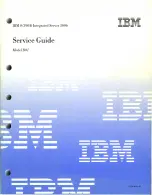
The process of planning and designing the use of resource groups for Copy
Services scope limiting can be complex. For more information on the rules and
policies that must be considered in implementing resource groups, visit the IBM
System Storage DS8000 Information Center, and select
Overview
>
Resource
Groups
to display topics which provide more detail. For specific DS CLI
commands used to implement resource groups, see the
IBM System Storage DS8000
Command-Line Interface User's Guide
.
Comparison of licensed functions
A key decision that you must make in planning for a disaster is deciding which
licensed functions to use to best suit your environment.
Table 9 provides a brief summary of the characteristics of the Copy Services
features that are available for the storage unit.
Table 9. Comparison of licensed functions
Licensed function
Description
Advantages
Considerations
Metro/Global Mirror
Three-site, long
distance disaster
recovery replication
A backup site is
maintained
regardless of which
one of the sites is
lost.
Recovery point
objective (RPO)
might grow if
bandwidth capability
is exceeded.
Metro Mirror
Synchronous data
copy at a distance
No data loss, rapid
recovery time for
distances up to 300
km.
Slight performance
impact.
Global Copy
Continuous copy
without data
consistency
Nearly unlimited
distance, suitable for
data migration, only
limited by network
and channel
extenders
capabilities.
Copy is normally
fuzzy but can be
made consistent
through
synchronization.
Global Mirror
Asynchronous copy
Nearly unlimited
distance, scalable,
and low RPO. The
RPO is the time
needed to recover
from a disaster; that
is, the total system
downtime.
RPO might grow
when link bandwidth
capability is
exceeded.
z/OS Global Mirror
Asynchronous copy
controlled by System
z host software
Nearly unlimited
distance, highly
scalable, and very
low RPO.
Additional host
server hardware and
software is required.
The RPO might grow
if bandwidth
capability is exceeded
or host performance
might be impacted.
Logical configuration overview
Before you configure your DS8000, it is important to understand IBM terminology
for storage concepts and the storage hierarchy.
Chapter 3. Data management features
67
Summary of Contents for DS8700
Page 2: ......
Page 8: ...vi Introduction and Planning Guide...
Page 10: ...viii Introduction and Planning Guide...
Page 20: ...xviii Introduction and Planning Guide...
Page 22: ...xx Introduction and Planning Guide...
Page 44: ...22 Introduction and Planning Guide...
Page 142: ...120 Introduction and Planning Guide...
Page 160: ...138 Introduction and Planning Guide...
Page 212: ...190 Introduction and Planning Guide...
Page 218: ...196 Introduction and Planning Guide...
Page 224: ...202 Introduction and Planning Guide...
Page 242: ...220 Introduction and Planning Guide...
Page 254: ...232 Introduction and Planning Guide...
Page 255: ......
Page 256: ...Printed in USA GC27 2297 09...
















































